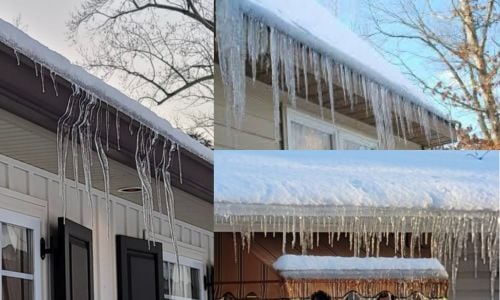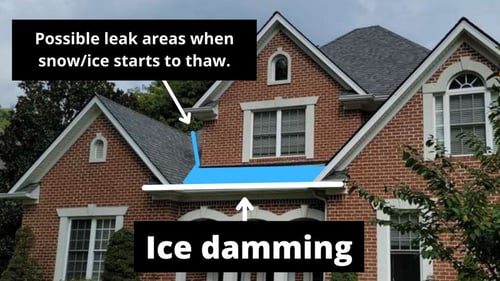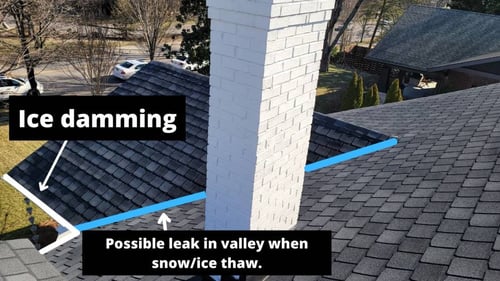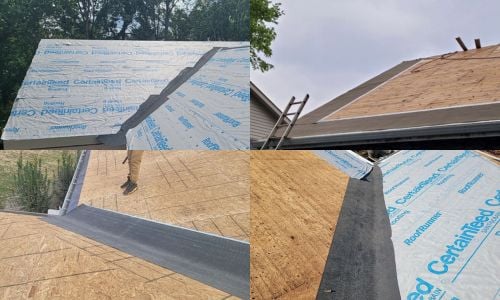Every time we get snow or ice, it’s guaranteed we’ll get calls about roof leaks. While the leak is coming from above, it’s not necessarily a problem with the roof.
Instead, water is finding its way inside due to ice damming. Unfortunately, this is way too common in our area of Middle Tennessee and other southern states.
But what exactly is an ice dam? Why does it cause leaks? Can you prevent it?
For over 30 years, the team at Bill Ragan Roofing has helped homeowners understand how ice damming impacts their roof and home. Because of this, I’ll answer the most common ice dam questions.
This article answers the following questions:
- What is an ice dam on a roof?
- How does an ice dam cause roof leaks?
- How do you prevent roof leaks caused by ice dams?
- Can you prevent ice dams from forming?
- How do you get rid of ice damming?
- Does homeowners insurance cover ice dams?
What is an ice dam on a roof?
An ice dam occurs on a roof when snow and ice freeze down by the gutter line (eaves) to create a literal dam of ice. The reason it’s called a “dam” is because it’s a literal blockage of ice that doesn’t allow water to drain once the snow thaws.

You can identify an ice dam by seeing an abundance of icicles hanging from your gutters. While most commonly seen at the gutter line, ice damming also occurs in your roof valleys, around a roof cricket, and where a valley comes in against a wall (deadpan valley).
Unfortunately, ice dams in roof valleys are harder to identify because they’re usually hidden under snow until everything starts to thaw.
How does an ice dam cause roof leaks?
Whether it’s at the gutter line or in a roof valley, an ice dam blocks water from draining down your roof. With the path blocked, water backs up and sits on a surface that isn’t meant to handle sitting water.
 (Example of how ice damming causes roof leaks)
(Example of how ice damming causes roof leaks)
This backed-up water eventually gets underneath your roofing materials and drips into your home until it’s warm enough outside for the ice dam to completely thaw out. There’s usually a lot of water, so make sure you have a bucket to catch the water coming into your home.
 (Example of how ice damming causes a leak in roof valley)
(Example of how ice damming causes a leak in roof valley)
Unfortunately, there’s nothing a roofer can do to stop leaks caused by ice damming when it’s already happening. However, there are things you can do to prevent ice dam leaks.
How do you prevent roof leaks caused by ice dams?
While there’s nothing you can do about ice dam leaks when they’re happening, there are things you can do when replacing your roof to prevent them in the future. One way is to install ice and water shield around the edges (rakes and eaves) of your roof that goes 2 feet past the interior walls of your home.
 (Ice and water shield installed on edges and in roof valleys)
(Ice and water shield installed on edges and in roof valleys)
If you can’t afford to do it at the edges, you can install ice and water shield in your roof valleys. On the other hand, deadpan valleys need metal or a membrane material installed in the valley and/or against the wall to prevent water from seeping into cracks.
Can you prevent ice dams from forming?
So, you can prevent ice dam leaks by installing the right materials in the right areas, but can you prevent them from forming in the first place? The truth is, it depends on your area, the climate, and the amount of freezing weather you get.
However, there are things you can do to make the likelihood of ice dams forming less likely. One way is to insulate your attic to prevent warm air from escaping through the roof.
This keeps your roof at the same temperature as outside, which prevents snow from melting and forming ice dams.
On top of insulating, proper attic ventilation reduces the chances of ice damming by expelling warm air and keeping the attic cool to maintain a consistent temperature. Another way to prevent ice damming is to keep your gutters and roof clear of debris.
Built-up debris already creates a dam that hinders drainage, and ice build-up makes it worse. Unlike a normal ice dam that melts, this one sticks around until the debris is gone.
How do you get rid of ice dams on your roof?
Some homeowners get on their roofs to get rid of ice dams with a hose, buckets of hot water, shovel, or rake, but this isn’t a good idea. Not only is it a huge safety risk, but it also can cause extensive damage to your roof.
Instead, you need to use specific roofing tools, such as a roof rake, to remove snow from your roof safely and efficiently. Before purchasing and using tools, do research to ensure they're roofing specific and won’t cause damage.
While more common in areas with frequent snow and ice build-up, there are also heat cables that can be installed on your roof to prevent ice dams from forming. However, this can cause other issues and a potential fire hazard.
Does homeowners insurance cover ice dams?
Unless specifically stated, homeowners insurance won’t usually cover the actual cause of ice damming. Depending on your policy, they’ll usually cover structural damage and personal property damage (clothing, pianos, TVs, etc.) caused by the leak.
However, homeowners insurance paying to fix the ice damming problem on your roof varies by location, insurance company, and policy. So, review your paperwork and talk to your agent about your options if your roof starts leaking from ice damming.
Are you experiencing a roof leak caused by ice damming?
Now you know what ice damming is, why it causes leaks, how to prevent it, and more. Unfortunately, all you can do is keep a bucket handy once the leaking starts.
And remember, don’t create more costly problems by trying to clear it without the proper tools. Instead, your best option is to hire a great roofing company to install the preventive measures we discussed earlier.
So, if you're experiencing a roof leak from an ice dam, you’ll need to find a great roofer in your area. To do this, you need the right tips to spot one in a sea of options.
If you’re local to Nashville, Franklin, Brentwood, or a surrounding Middle Tennessee area, don’t hesitate to Request a Quote to discuss how you can avoid ice damming leaks in the future.
Check out 7 Tips to Find a Great Roofing Contractor to get your ice damming issues taken care of by a reputable roofing company.



